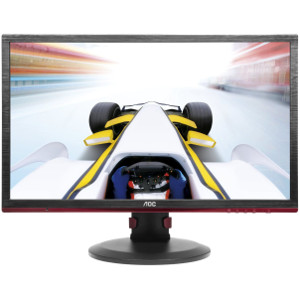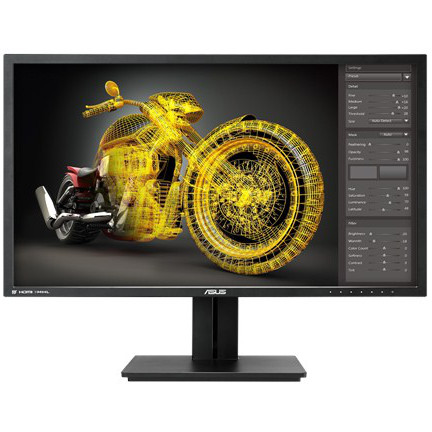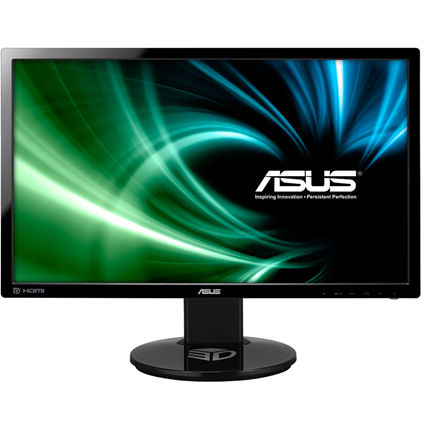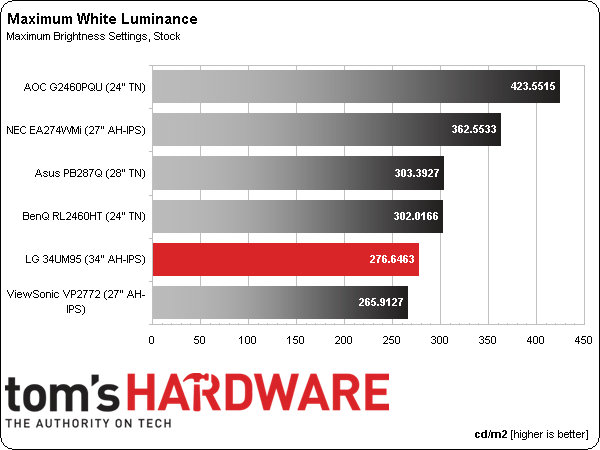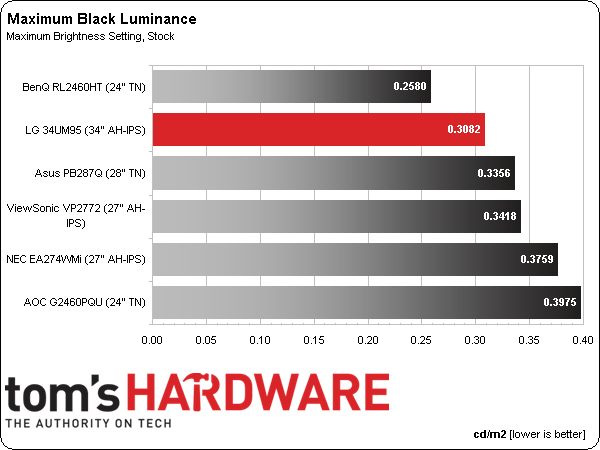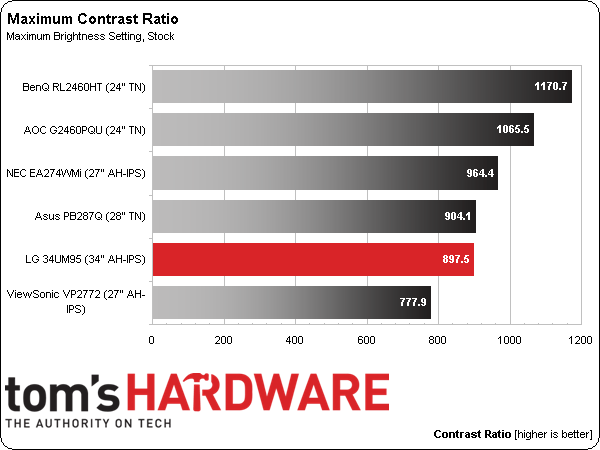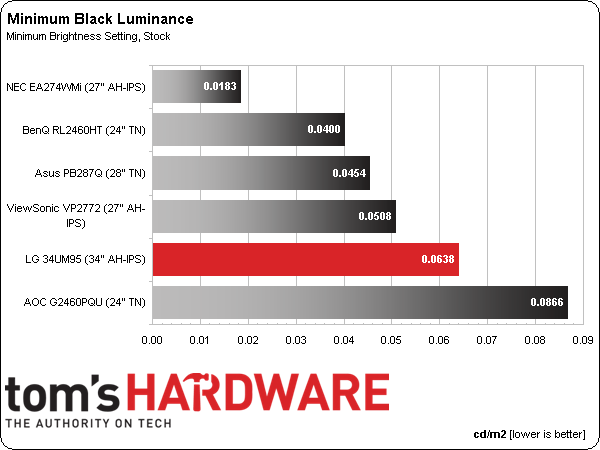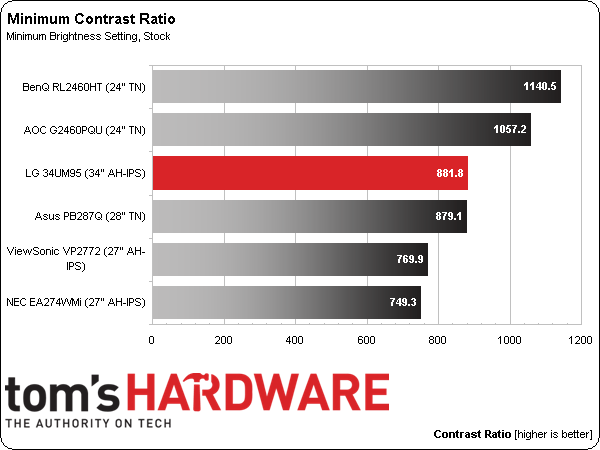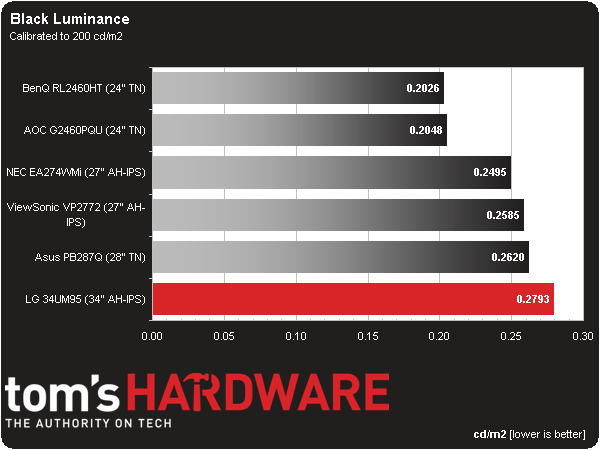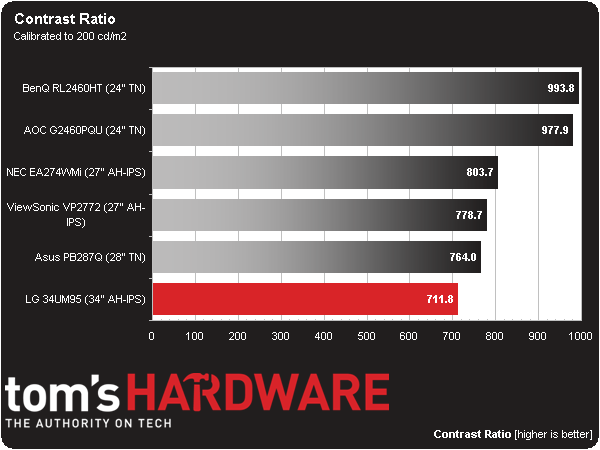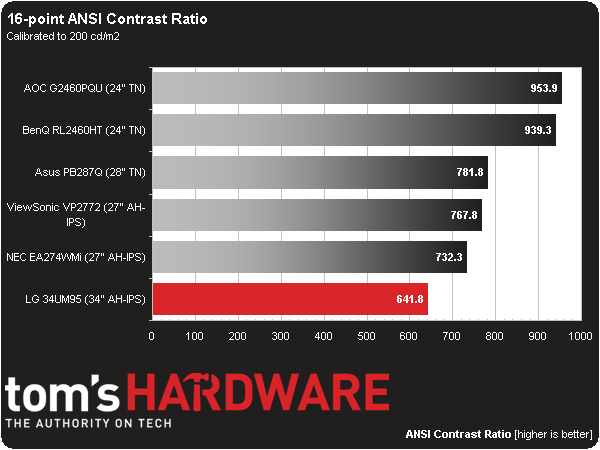LG 34UM95 34-Inch Ultra-Wide QHD Monitor Review
When we looked at 29-inch ultra-wide displays last year, we asked for greater size and more pixels. LG answers that request with its 34UM95, a 34-inch panel with a resolution of 3440x1440. Today we run it through our performance and usability analysis.
Results: Brightness And Contrast
Uncalibrated
Before calibrating any panel, we measure zero and 100-percent signals at both ends of the brightness control range. This shows us how contrast is affected at the extremes of a monitor's luminance capability. We do not increase contrast past the clipping point. While doing this would increase a monitor’s light output, the brightest signal levels would not be visible, resulting in crushed highlight detail. Our numbers show the maximum light level possible with no clipping of the signal.
The greatest light output is available through the 34UM95’s Photo picture mode. The monitor comes from the factory set to Custom, though that only results in a peak white measurement of 249.9291 cd/m2, under LG’s 320 cd/m2 specification.
The black level at maximum brightness is decent, but that’s partially because of the lower white level. We noticed when displaying a zero-percent pattern that the backlight would shut completely off after a few seconds. You probably wouldn’t experience this behavior during normal use. However, it made our black level measurements a little tricky.
The max contrast level is a little lower than most other IPS screens. We like to see displays achieve at least 1000 to 1, so the 34UM95 isn’t too far off. Our results make it pretty obvious that TN still has the edge there, though.
We believe 50 cd/m2 is a practical minimum standard for screen brightness. Any lower and you risk eyestrain and fatigue. The 34UM95 bottoms out at 56.2552 cd/m2, which is great for playing games or working in a completely dark room.
A black level measurement of .0638 cd/m2 is decent, but other monitors we’ve tested go a little lower. The important thing is that the contrast ratio remains fairly constant as we turn down the backlight.
The difference between the 34UM95’s maximum and minimum contrast is negligible. It’s not quite as high as I'd like. Then again, I'm picky. Fortunately, the image quality you can expect from actual content is quite good with plenty of depth and pop.
Get Tom's Hardware's best news and in-depth reviews, straight to your inbox.
After Calibration
Since we consider 200 cd/m2 to be an ideal point for peak output, we calibrate all of our test monitors to that value. In a room with some ambient light (like an office), you get a sharp, punchy image with maximum detail and minimum eye fatigue. On many monitors, this is also the sweet spot for gamma and grayscale tracking, which we'll look at on the next page.
In a dark room, many professionals prefer a 120 cd/m2 calibration. We have found it makes little to no difference on the calibrated black level and contrast measurements, though.
The black level is not significantly affected after calibration. Because the RGB sliders default to the center of their range, grayscale can be adjusted in a more balanced manner. When the controls begin at their maximums (like the majority of monitors), you can only reduce contrast as you dial in the grayscale.
We give up some performance here because we have to reduce the Contrast control in order to clean up the 100-percent white point. If you opt to leave Contrast at its default setting, you can expect about 900 to 1 instead. Our result represents the lowest possible grayscale error and is therefore a compromise.
ANSI Contrast Ratio
Another important measure of contrast is ANSI. To perform this test, a checkerboard pattern of sixteen zero and 100-percent squares is measured, yielding a somewhat more real-world metric than on/off readings because we see a display’s ability to simultaneously maintain both low black and full white levels, factoring in screen uniformity, too. The average of the eight full-white measurements is divided by the average of the eight full-black measurements to arrive at the ANSI result.
The ANSI measurement takes a hit due to the 34UM95’s poor black field uniformity, which we’ll show you on page eight. There are hotspots along the panel’s bottom edge that elevate the readings enough to drop ANSI contrast by another 28 percent from the maximum number. If you return the Contrast control to its default setting, the result improves to 773.4 to 1.
Current page: Results: Brightness And Contrast
Prev Page Measurement And Calibration Methodology: How We Test Next Page Results: Grayscale Tracking And Gamma Response
Christian Eberle is a Contributing Editor for Tom's Hardware US. He's a veteran reviewer of A/V equipment, specializing in monitors. Christian began his obsession with tech when he built his first PC in 1991, a 286 running DOS 3.0 at a blazing 12MHz. In 2006, he undertook training from the Imaging Science Foundation in video calibration and testing and thus started a passion for precise imaging that persists to this day. He is also a professional musician with a degree from the New England Conservatory as a classical bassoonist which he used to good effect as a performer with the West Point Army Band from 1987 to 2013. He enjoys watching movies and listening to high-end audio in his custom-built home theater and can be seen riding trails near his home on a race-ready ICE VTX recumbent trike. Christian enjoys the endless summer in Florida where he lives with his wife and Chihuahua and plays with orchestras around the state.
-
rantoc 4k gaming is amazing but demand alot from the computer hardware. Just got a dell 3214 and its hard to describe how much better the picture/emersion is with the way higher definition in the picture quality and still came from descent 2560x1600 before that.Reply
Playing on "full" hd (LD? Low definition) feels like a joke once you get to know uhd/4k -
wtfxxxgp Rantoc, what does your comment have to do with the article? Seems to me that you were waiting for an opportunity to brag about your new monitor... Glad you got that out of your system. lolReply
With regards to this monitor...I LOVE the looks...very elegant. I think the price tag is fitting as well - it has great resolution and there are still plenty of people who are gaming on 60hz displays that may have just enough GPU power to actually game at this thing's native resolution, albeit with slightly lower settings. GG LG! -
xPandaPanda I have this monitor. Because of it's cinema format, market age, lower production numbers, and early adoption as competitors haven't offered this yet, it is reasonable to think this monitor would cost this much--a lot.Reply
It would have been nice to include what revision this is, because LG is aware of uniformity issues, which is why the product was largely on backorder and a Rev.2 is in place (but Rev. 2 didn't fix the problem either). My first one had a glaring Uniformity problem, but LG is cool and offered an advanced exchange. The new one has some uniformity problem, but it is very 'livable' and discrete.
Overall, I am pleased with this product. I have a single 780 to push this and it works nicely. If I got a 4k monitor, I'd have performance issues as the GPU as a whole sector is behind.
-
eklipz330 as a pc gamer who has been playing for ~15 years, i have to say that this is one of the biggest changes that i've seen on the pc platform. this is a big step towards bringing pc back to relevancy. it's something that will be held to acclaim in productive and gaming environments. in fact, the only thing that i'm surprised that they didn't do is make it curved, simply because when a user sets up a multi-monitor setup, they set the outside monitors at an angle. this makes curved monitor solutions make sense more so than tvs, especially since curved monitors benefit solo users the most. im shocked they didnt make it curved. probably going to cash in next year on that.Reply
seriously though, pc monitors have been lacking for some years now, falling behind in innovation and technology in general(phones have been jacking up their screen quality year after year, we've been stuck since like 2005). i bet 21:9 screens will have the biggest penetration on PCs. -
josejones Why still the old HDMI 1.4 instead of HDMI 2.0 and DisplayPort 1.2 instead of the new 1.4 ???Reply
